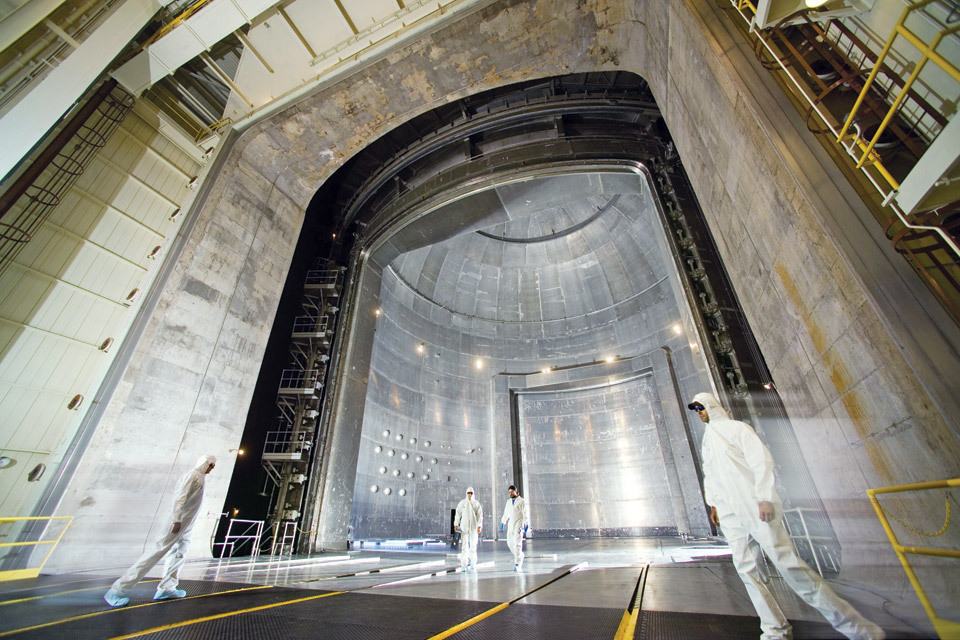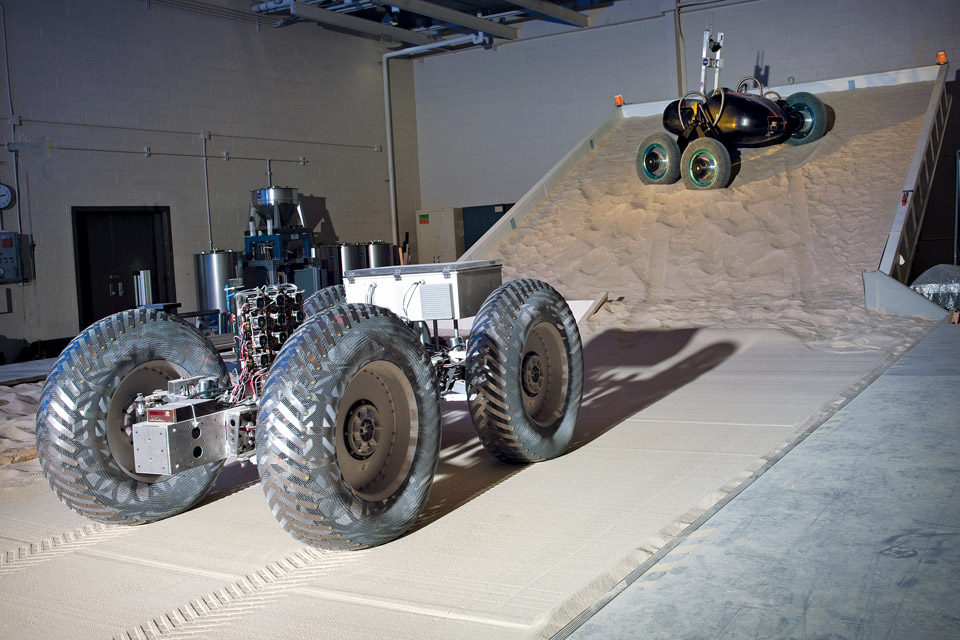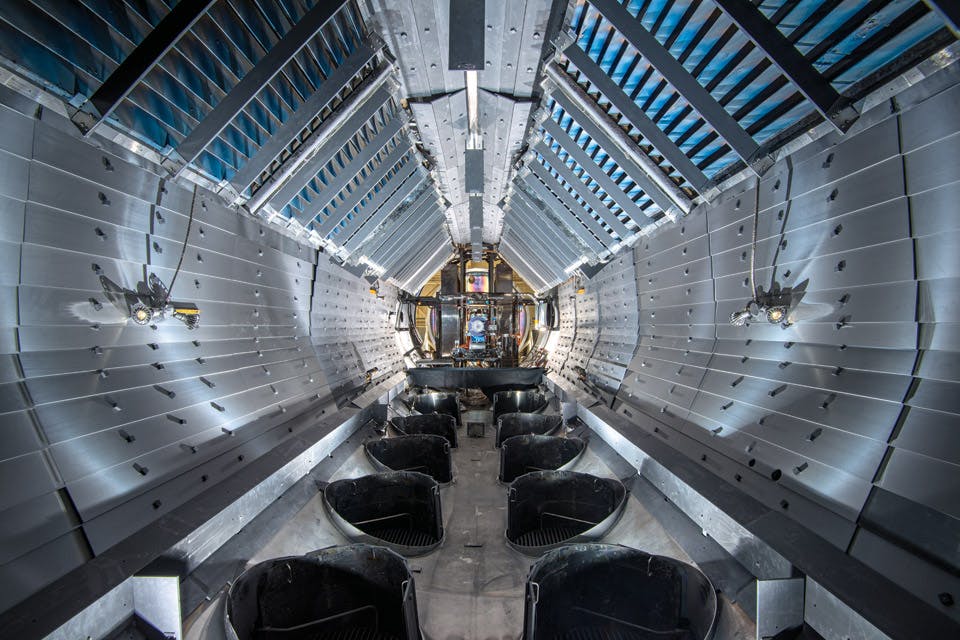How NASA’s Ohio Research Facilities are Shaping the Future
See the work going on today at Ohio's NASA sites that will one day help us reach Mars.
May 2016 Issue
BY Jim Vickers | All photos courtesy of NASA
May 2016 Issue
BY Jim Vickers | All photos courtesy of NASA
As you read these words, the future of super-efficient space propulsion is anchored inside a long metal vacuum chamber at NASA Glenn Research Center in Cleveland. The device is roughly the size of a hubcap, but the promise it carries is as great as the distances it will one day help us cover.
The thruster will remain running in this airless, space-like environment until testing ends in August. All the while, computers are measuring critical information about its performance — just another link in a chain of technological advances that will allow us to more easily travel through space in the years and the decades to come.
If you’ve ever wondered about the status of our nation’s focus on space exploration in the post-space shuttle era, know that the work has not stopped. Inside NASA’s Ohio facilities in Cleveland and Sandusky, innovation and research is happening every day that is not only cementing the future of space exploration but also providing advances in aeronautics, which at one time seemed as fanciful as the idea of sending men and women to Mars.
This year marks NASA Glenn Research Center’s 75th anniversary, and to celebrate the occasion, the government agency is hosting public open houses at Lewis Field in Cleveland on May 21 and 22 and at Plum Brook Station in Sandusky on June 11 and 12. It is the first time in eight years that the NASA sites have opened their doors for members of the general public to step inside and be inspired.
Earlier this spring, we visited both to get a closer look at some of the research areas that are forging the future of space exploration. They are just a few of the many projects being worked on by more than 3,000 Ohioans. What we encountered was fascinating and exciting. It’ll change the way you think about our planet and the possibilities that lie beyond it.
***

The Countdown Begins
Home to the largest vacuum chamber on Earth, Plum Brook Station in Sandusky simulates how the dramatic stresses of liftoff and space affect a variety of hardware, including components for the Orion spacecraft that will take us to Mars.
The heart of Plum Brook Station’s Space Power Facility is 100 feet in diameter and 122 feet high. The silo-like room has an 8-foot-thick concrete shell and two 50-foot-square doors that weigh 5 million pounds each and must be driven into place each time they are opened or closed.
It’s a seldom-glimpsed space, but if you’ve watched the beginning of the superhero film “The Avengers” you’ve seen it. In 2011, movie crews spent a month at the NASA research facility, which is part of a 6,400-acre campus just down the road from Cedar Point, to make use of the vacuum chamber’s futuristic look.
The structure was built in 1969 as the Apollo missions were winding down, with the idea of using it to test nuclear and non-nuclear space power-propulsion systems. The nuclear tests never happened, but the chamber is the ideal environment for re-creating the realities that exist beyond our planet’s atmosphere.
“We pump all the air out, and we get down to space-like conditions,” says Space Power Facility site manager Jerry Carek. “In space, not only is there no air, but things get really hot and really cold. You’ve got the sun shining on a spacecraft on one side. The other side, you’re exposed to deep space, which is super cold.”
Conditions within the chamber can swing from 400 degrees to minus-280 degrees Fahrenheit based on testing needs. The heating is done by way of electric-powered infrared heaters, and liquid nitrogen is flowed through large metal panels inside the chamber to create extremely low temperatures.
The lobby at the Space Power Facility is decorated with photographs of many of the projects that have passed through its doors. Early on, the facility tested the fairings — the metal shell that protects a payload during launch before falling away — for the Skylab space station and the Titan rocket booster. One photo shows the testing of the International Space Station’s deployable radiators.
“There were lots of issues that had to get solved during that program,” Carek says, pointing to the white panels that help dispose of the heat the station produces. “If you look at pictures of the space station now, you’ll see those out there.”
Another photo depicts the testing of the huge airbags vital to the successful touchdown of the Spirit and Opportunity Mars rovers. A different, larger photograph nearby shows an image captured by Spirit soon after it landed. The fabric of the mission-critical airbags is clearly visible along the bottom of the frame.
“When we started testing the baseline design, they were tearing and breaking and not working at all,” Carek says. “They ended up going with a whole bunch of layers ... abrasion layers that were intended to tear away when they hit the sharp rocks and others layers that were intended to keep the nitrogen inside.”
Although the facility’s track record of past successes is fascinating, so is the work it’s doing now for the Orion program, a new spacecraft that will take astronauts farther than they’ve ever gone before, including Mars. The vehicle will be launched atop the largest rocket ever built, and a new launch system will include an abort capability that can save the crew in the event of a malfunction during liftoff. Exploration Mission 1, the first unmanned flight of the new launch system, is currently scheduled for 2018.
Naturally, the work for Orion is already going on and part of it is happening at Plum Brook’s Space Power Facility. The Orion service module, which connects to the crew capsule and sustains the astronauts during the mission, is undergoing vibration and acoustics testing to see how it reacts to the stresses of launch.
“It’s a wicked, wicked two minutes for the people and for everything they’re flying — all of the computers, all of the electronics,” says Carol Ginty, project manager for NASA Glenn. “Rockets are very, very expensive to launch, and you want to make sure that whenever you get to where you need to go, that everything is going to deploy, everything is going to turn on, and you don’t lose your mission.”
For that, the Space Power Facility built vibration and acoustics testing areas in a large bay adjacent to the vacuum chamber. During acoustics testing, the service module is blasted with up to 163 decibels of noise at various frequencies from 32 horns. Then, it is on to the shaker table, a platform that can support 75,000 pounds and shake on three axes. It is set in 15 million pounds of concrete, which in turn has 106 bolts sealed with epoxy anchoring it to the bedrock beneath the facility.
During testing, a mass simulator equal to the weight of Orion’s crew vessel is placed atop the service module in order to generate the most accurate physical reactions to the movement. Once testing is complete, data is sent on to the European Space Agency that built it (Orion is an international effort) so any tweaks can be made to the final version.
“Testing is important,” says Carek. “It’s expensive, but it’s relatively cheap compared to the cost of failure.”
***

Reinventing the Wheel
From exploring the permanently shadowed poles of the moon to navigating the challenging surface of Mars, NASA’s Simulated Lunar Operations Lab envisions and tests tires that stand up to out-of-this-world conditions.
Everyone who has watched their car’s tires spin helplessly in a foot of snow knows the sinking, frustrating feeling. Now, take that and amplify it by years of research, untold hours of manpower and millions of dollars, and you begin to get an idea of the stakes present in what Colin Creager and his fellow researchers are working on at NASA’s Simulated Lunar Operations Lab in Cleveland.
Sure, it may look like hours of playing in the sandbox when you spot the lab’s two 10-by-60-foot testing areas and 20-by-16-foot adjustable tilt bed (complete with a fun-looking vehicle named Scarab). But the large testing areas, which can be filled with materials that simulate the terrain of the moon or Mars, are critical to the success of future unmanned rovers. One of the lab’s current projects is designing wheels for a vehicle that will be used in a mission to explore the permanently shadowed regions at the poles of the moon to look for ice.
“But it has some challenges associated with it,” Creager explains. “When you’re in these craters, there is no sunlight. If you’re using your solar power, you can’t charge the vehicle, so you need to be able to get in and out quickly.”
To complicate matters, previous moon missions have never reached the poles. It’s unclear whether the same conditions apply in these regions of constant shadow as they do in the moon’s well-studied equatorial areas.
“There are a lot of theories swirling around about what the soil is actually going to be like,” Creager says. “As mobility folks and tire designers, we have to come up with wheels that can drive through whatever.”
To find patterns that will get the most traction, the Simulated Lunar Operations Lab creates different sections of tread using a 3-D printer and then tests them on a metal hub to measure how each performs. “Right now we’re trying to figure out what’s the optimal size and tread pattern,” Creager says.
The Simulated Lunar Operations Lab is also designing compliant tires for potential use on future Mars rovers. A compliant tire can change shape when pressure is exerted on it and then return to its original form. It’s how our rubber tires on Earth operate. They do quite well for us, but they won’t hold up on the moon or Mars.
“Rubber becomes very brittle in cold temperatures, which can make it prone to cracking,” Creager says. “If you get a crack in it, even just from a small pebble, you can get a hole and then a flat tire. … On Mars, you can’t exactly call AAA.”
The first Mars rover, Sojourner, weighed 50 pounds and had six small rigid wheels. It traveled only about 100 meters on the planet’s surface, but it was never expected to go far. Spirit and Opportunity, which followed in the 2000s, weighed a couple hundred pounds each and had slightly larger solid wheels. Curiosity, which reached Mars in 2012, is the size of a small car. To meet mass requirements for launch, it was outfitted with wheels that have a thin aluminum surface less than a millimeter thick.
“The loads these rovers are seeing are actually higher than expected,” Creager says, as he shows an example of one of Curiosity’s wheels. “The terrain is rockier, and the way this thing moves around, it’s got a lot of stress at certain points … They’re getting cracks the size of quarters — holes — in the skin of these wheels.”
Another issue NASA has encountered on Mars is pockets of windblown sand. Mars’ winds pick up the top layer of soil and redeposit it, over time creating fields of these small and light particles that are rounded due to wind erosion and very hard to drive through. “[It’s] kind of like a jar of marbles or the ball pit at Chuck E. Cheese or McDonalds,” Creager says.
As Mars rovers become larger, Creager says solid wheels seem to be reaching their limits of effectiveness. Interestingly, the future of effective compliant tires for Mars rovers may end up coming from a mesh-like wheel design initially used during the Apollo moon missions.
“The limitation though is they only are designed for 60 pounds of load [per tire],” Creager explains.
Trying to scale up the Apollo design to fit the load needs of future Mars rovers made the mesh brittle. But thanks to a partnership with the Goodyear Tire and Rubber Co., this spring Creager and his colleagues created a mesh-wheel prototype with innovative new metal materials. Creager says they hope the design will eventually be used on the vehicle sent to retrieve samples collected by the next Mars rover, which is set for a 2020 launch.
“This will be the first of several [prototypes] we plan on making if we can get money from NASA’s Center Innovation Fund to advance this technology to the point it would be considered for future Mars missions,” he says.
***

Power Plan
Ultra-efficient propulsion is vital to the future of space exploration. NASA’s Electric Propulsion Laboratory is working on the system that will make it happen.
Space exploration is very expensive, and it doesn’t have as much to do with distance as it does gravity. The energy required to break free of the Earth’s pull is immense and, consequently, so is the price tag associated with doing so.
“In order to get to that altitude and stay in orbit, you have to be going really, really fast … 18,000 miles per hour,” says Dave Manzella, a senior propulsion engineer at NASA Glenn Research Center. “Accelerating things to that speed takes a lot of energy and that results in a lot of costs.”
You can’t solve the high costs associated with a launch, but once you escape Earth’s gravitational field, traveling through space gets a lot less expensive when you’re pushing a vehicle with high-power solar electric propulsion. NASA’s Electric Propulsion Laboratory is currently working to develop this new, incredibly efficient technology that will make it possible to undertake missions that are now extremely costly or impractical.
“A lot of what we launch [now] is rocket fuel to go other places,” says Manzella. “In some cases, it’s more than half of what we launch. … So really, the reason we work on solar electric propulsion is economics.”
The Electric Propulsion Laboratory in Cleveland dates back to the 1960s. It’s home to two large vacuum tanks (one is 15 feet in diameter and 60 feet long, the other measures 25 feet in diameter and 70 feet long) that simulate space conditions and allow the flowing of gases necessary to test this new form of propulsion. Mike Barrett, deputy chief for the Space Technology Project Office, says such an advance has many potential uses, but one of them would include staging supplies in the lead-up to manned Mars missions.
“If we’re sending humans to Mars, it’s likely that we’re going to pre-position a habitat there or a logistics module, so there’s already some stuff there that will either help them as they spend time there or help them get back,” Barrett explains. “The most efficient way to do it is with electric propulsion.”
The technology works The technology works by capturing energy from the sun and converting it into electricity. That electricity, in turn, powers a thruster that expels ions created from xenon — a high-density gas that can easily be taken into space in large quantities — to push the vehicle forward. One of the main pieces of such a propulsion system is a solar array — essentially a large blanket of solar cells that can be stowed for launch and then unfurled in space to collect power from the sun. NASA has used solar arrays for a long time, but the newest are more powerful.
The other big piece of the electric propulsion equation is the ion thruster, which is now undergoing testing in one of the Electric Propulsion Laboratory’s vacuum chambers. It has about 15 kilowatts of power (the equivalent of about a dozen hair dryers) and exerts a quarter-pound of thrust. But in the vacuum of space, that small amount can do a lot.
“We would envision combining several of these [thrusters],” Manzella explains. “Right now we’re targeting systems of about 50 kilowatts. At that level, we can push things around [in space].”
For more information, visit nasa.gov/centers/glenn.
Related Articles
.jpg?sfvrsn=17edb738_5&w=960&auto=compress%2cformat)
How an 11-Year-Old From Logan Became a Lego Legend
Bentley won the title of Legoland Discovery Center Columbus’ Mini Master Builder for 2025. READ MORE >>

Ohio Love Staff Picks: March 2025
From a beloved pancake breakfast in Burton and a former factory in Mount Vernon to an iconic piece of Cincinnati history, here’s what our staff loves about Ohio this month. READ MORE >>

Ohio Finds: Clyde Singer’s “Beaten Ball Club”
Born in 1908 in Malvern, Singer was a natural artist. He created this painting in 1949. READ MORE >>



